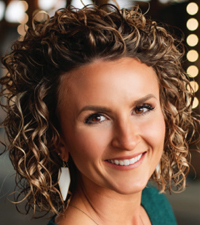When we choose to be more energy efficient, we see benefits environmentally and economically. According to the EPA, energy efficiency can lower greenhouse gas emissions and other pollutants, as well as decrease water use. It can also lower utility bills, create jobs, and help stabilize electricity prices. If you are interested in how to become more energy efficient in your home or office, keep reading to hear what local experts suggest!
Solar Power

Molly Livingston
Everlight Solar
Solar power continues to become more widespread with home and business owners, so to learn more about this popular new energy alternative, we went to Everlight Solar (everlightsolar.com), a solar energy company that offers a cleaner way to power your home.
“Solar reduces your carbon footprint by producing emission-free electricity for its lifetime. On average, installing solar on your home will be as beneficial as planting more than 100 trees every year,” said Marketing Team Lead Molly Livingston.
“Solar energy provides a pathway for the United States to become fully independent. Homeowners who go solar help lower the United States foreign energy dependence and protect from price fluctuations in global markets. Solar power produces clean energy that aids in resolving climate change compared to traditional sources like natural gas or fossil fuels.”
Everlight Solar uses premium, low-profile, jet black panels that lay flat on your roof, making them aesthetically pleasing to the eye. They are a proud installer of select Tesla products and are excited to continue to grow their business and offerings in 2022.
“The two main reasons homeowners go solar involve protecting the environment and saving money,” explained Molly. “Solar energy reduces your carbon footprint, upgrades your home efficiency, and improves your property value. Going solar also includes excellent financial benefits. Solar energy employs more people than coal, oil, and gas. In addition, it promotes national energy independence. The United States offers incentives for those who choose to switch. These incentives, such as tax credits and rebates, lower the net cost of your solar panel system.”
Everlight Solar saw the demand for renewable energy in the Omaha area, so they moved into the market to bring their cleaner energy solutions to the community. Not only does this offer an energy alternative, but the solar industry has created so many more jobs!
“Whether you choose to go solar for the economy, the environment, or yourself, solar energy benefits everyone.”
An Array of Benefits
The benefits to a company’s bottom line should be motivation enough to reduce greenhouse gas emissions, but Matt Neal, B2B Demand Generation Strategist for Omaha Public Power District (OPPD, oppd.com), explained that some benefits may not be as clear.

Matt Neal
Omaha Public Power District (OPPD)
“These additional benefits may include improved building comfort levels, reduced maintenance demands, and upgraded building control integration,” said Matt. “Doing the right thing is easier now. Plus, most products will pay for themselves over time. OPPD’s commercial energy efficiency projects typically have a two to four year simple payback.”
Matt said that he finds the most common culprit of energy loss to be less efficient heating and cooling systems. Outdated (non-LED) lighting fixtures or obsolete lighting controls will also increase energy use. OPPD Energy Consulting can provide solutions to reduce utility costs up to 65%.
“OPPD has many product and service offerings for both residential and commercial customers,” said Matt. “Homeowners can easily start to improve their energy efficiency by upgrading to LED lighting and purchasing a smart thermostat with built-in programming to help optimize your heating and cooling system operation. Check out OPPD’s Smart Thermostat and Cool Smart programs to take advantage of available rebates. HVAC rebates are also available for new AC or heat pumps (15 SEER or higher). Businesses have more complex HVAC systems, but OPPD is your direct line of communication to prioritize your needs.”
Other services include energy efficiency consulting, Energy Star evaluations, energy monitoring solutions, and on-site generation programs (traditional and renewable generation). OPPD aims to lower your utility costs through a variety of building optimization strategies, patented technologies, and commercial rebates, and their consultative process is tailored to meet the specific objectives of their customers.
“Account executives work with businesses throughout the community – large and small – that have taken advantage of OPPD’s Energy Consulting service,” Matt shared. “From our exclusive rebates to our industry-leading technology, the strategies our team delivers always generate serious results. Don’t hesitate to reach out to us today – we look forward to hearing from you!”
Streamline Your Way to Savings
The Streamline Energy Solutions (streamlineenergysolutions.com) team of energy-efficiency specialists operates with the goal of saving energy—and saving you money. They pride themselves on being a one-stop-shop for all of your home energy-efficiency needs, providing various insulation and weatherization services, coupled with a crucial blower door test, to create immediate improvements in how your home uses energy.

Jen Keller
Streamline Energy Solutions
“One of the biggest upgrades we recommend to create the maximum impact when someone wants to insulate their home is air sealing,” said Streamline Co-founder and BPI-Certified Auditor Jen Keller. “We’ll locate all the accessible crevices in your attic, including around your fixtures and top plates and seal them so to prevent conditioned air from leaking into the attic space. That preps the attic for us to insulate with blown-in fiberglass. We prefer this product over cellulose because it doesn’t settle over time, does not absorb moisture, and is a lot cleaner product. Of course, the baffles we install in an attic are a crucial step in the process, too, because they keep the insulation from blocking air flow through your soffit vents and provide necessary ventilation. Proper attic ventilation reduces the risk of ice dams in the winter and the build up of condensation in the attic space, which could lead to mildew or mold.”
Streamline uses CertainTeed Insulsafe SP blown-in insulation not only because it doesn’t settle but also because it provides better coverage, excellent sound control, lasts for the life of your home to reduce long term energy demand and costs; is environmentally sustainable and formaldehyde-free; and comes with a limited lifetime warranty. This isn’t your typical itchy fiberglass. It is actually soft to the touch! Another fabulous offering from Streamline Energy Solutions that is not universal to all insulation companies is a blower door test because not everyone is BPI (Building Performance Institute)-certified to administer them. As a BPI-certified auditor, Jen starts by connecting the blower door device to one of the exterior doors of your home to audit energy loss.
Jen also owns Halo Custom Lighting, which can help you light up your home with permanent energy-saving LED lighting for the holidays—or all year long. This sister business has become tremendously popular with versatile and fully customizable lighting options for your home.
Comfortably Efficient

Pat Killeen
Engineered Controls
Pat Killeen, owner of Engineered Controls (engineeredcontrols.com) believes both comfort and energy efficiency are achievable with the right tools.
“Today more than ever, building owners want their facilities to be environmentally responsible and healthy places to live and work,” emphasized Pat. “They also want to optimize the energy usage without compromising comfort. Together a tall order to accomplish, but at Engineered Controls that technology is available today.”
Engineered Controls can play a very big part in assisting new and existing building owners with controlling their buildings’ energy costs. Considering the fact that a building’s lighting and HVAC loads account for nearly 80% of a building’s energy usage, there are plenty of energy strategies that a Building Automation System can provide maximizing the energy strategy options available to building owners. Essentially, Engineered Controls can assist in total building control and help provide a healthier and more energy-efficient environment for occupants.
“To help our customers in identifying efficiency areas in their buildings, Engineered Controls, in conjunction with Honeywell Inc., developed an Energy & Environmental Optimization (EEO) program,” Pat explained. “It is designed to leverage a broad portfolio of energy efficiency products and solutions, as well as offer a high level of energy expertise to commercial buildings in the hands of our skilled, knowledgeable, and certified EEO professionals. Our EEO team can help building owners and managers obtain real-world data to help them make fact-based decisions about how to optimize their buildings for occupants’ comfort while saving energy at the same time.”
Thermal Imaging
If you are looking to get a better idea of where your business’s energy inefficiencies are, contact Mirage Aerial Imaging (mirageaerial.com). They provide baseline and post-damage structural assessments of commercial buildings through a drone controlled from the ground that can capture a sky-view of your building. Their aerial thermal assessments improve energy efficiency in commercial buildings because they identify water infiltration beneath the surface of the roof, which can drain energy.

Tom vonAhlefeld
Mirage Aerial Imaging.
“It is advised for the health of any low slope or flat commercial roof that you have a regular maintenance schedule consisting of visual inspections, cleanings, and regular Certified Roof Inspector visits,” said Tom vonAhlefeld, who owns the company with his wife, Sara. “An aerial thermal image provided by Mirage Aerial Imaging can assist in the inspection process by directing inspectors and building managers toward areas of potential water infiltration.”
Thermal scans show temperature differentiations and, if water potentially infiltrated a roof’s outer membrane, the
underlying insulation would be wet. Wet insulation holds heat from the sun longer than dry insulation, allowing the thermal camera to “see” a temperature difference. These temperature differences are noted through different colored pixels in the photo. Each pixel color represents a temperature that correlates to the color palette being used; for example, red pixels may signify 70 degrees Fahrenheit.
“The entire roof can be seen on one image and compared to a high resolution photograph,” Tom said. “We can also detect and confirm leaks early, decreasing overall maintenance costs due to unidentified leaks. Thermal imaging also potentially allows for targeted roof repair rather than replacement, and decreases energy costs.”
We should all try to be more energy efficient, but if you’re unsure of where to start, we recommend contacting these local professionals. They have the tools and resources you need to relish in the benefits that come with energy efficiency!

